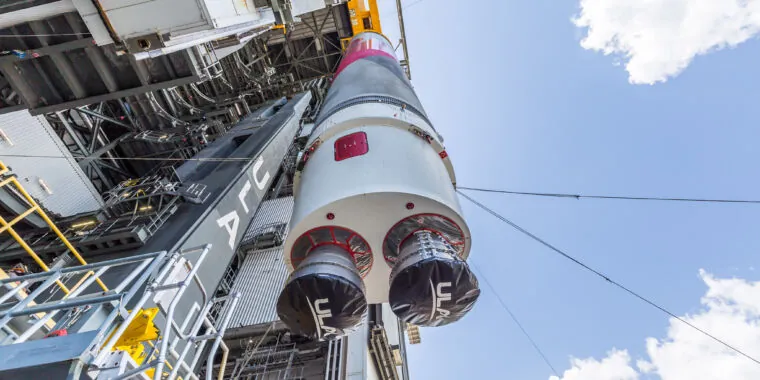
NASA Gears Up to Buy Vulcan Rockets: The New Era of Space Launching Begins!
2024-09-24
Author: Ling
In a groundbreaking move, NASA is now poised to enter into contracts with United Launch Alliance (ULA) for its newly successful Vulcan rocket. This decision comes hot on the heels of a stellar test flight that signals the end of SpaceX's monopoly on launching NASA's extensive scientific missions.
For years, ULA found itself sidelined when it sold its fleet of Atlas V rockets, primarily to support Amazon’s Project Kuiper for satellite internet. This move restricted ULA from bidding on NASA contracts as they waited for the Vulcan rocket to complete a successful mission. Tim Dunn, NASA's senior launch director, explained that the Vulcan had to achieve this milestone before being eligible for future launch contracts.
The Vulcan rocket made headlines with its inaugural certification flight, dubbed Cert-1, which took place on January 8. The mission showcased the rocket’s impressive methane-powered BE-4 engines, developed by Blue Origin, and an upgraded twin-engine Centaur upper stage. With its second test flight, Cert-2, scheduled for no earlier than October 4 from Cape Canaveral Space Force Station in Florida, the Vulcan is on track to potentially launch its first official mission by year's end.
Back in the Game: A Powerful Lineup of Launch Options
NASA's Launch Services Program (LSP) oversees the selection and monitoring of launch providers for robotic scientific missions. Currently, NASA could deploy several rockets for upcoming large missions, including SpaceX's Falcon 9, Falcon Heavy, ULA's Vulcan, and Blue Origin's New Glenn. However, since ULA's Atlas V sales two years ago, SpaceX had been left standing alone, winning contracts such as the launches for the GOES weather satellite and the Roman Space Telescope.
The playing field has shifted dramatically. Once the exclusive launch partner for NASA and military satellites for nearly a decade, ULA's standing is being rejuvenated amid strong competition. Dunn noted, "With their remarkable success on Cert-1, ULA is now ready to bid for future missions.”
Although the Vulcan rocket has yet to be formally certified by NASA for scientific missions, this hasn’t stopped the agency from recognizing its potential. Upcoming significant missions ripe for launch contracts include the adventurous Dragonfly mission, which aims to explore Titan, Saturn’s moon, and the asteroid-hunting NEO Surveyor telescope.
The Pressure is On: Cert-2 on the Horizon
The upcoming Cert-2 flight is crucial for both ULA and the U.S. Space Force as it will provide vital data about the rocket's capabilities. Lt. Gen. Philip Garrant of Space Systems Command expressed optimism, stating, “We expect ULA to be ready to execute their first Space Force missions with the Vulcan rocket by the end of this year.” He emphasized the urgency for ULA to complete the certification, indicating that preparations for subsequent missions are already in place.
Furthermore, Blue Origin's New Glenn rocket seeks to break into the competitive scene as it eyes bids for NASA's more expensive, large-scale missions following its initial successful flight. Meanwhile, for smaller missions, the New Glenn rocket has already been assigned to the ESCAPADE mission to Mars.
In a significant development, ULA just finished building its second Vulcan rocket at Cape Canaveral, featuring a dummy payload instead of a satellite. The second Vulcan launch was initially intended to carry Sierra Space’s Dream Chaser to the International Space Station, but challenges have delayed those plans.
As the space industry races towards new horizons, with major players like SpaceX, ULA, and Blue Origin contending for critical contracts, the excitement around ULA’s Vulcan rocket is palpable. The dawn of a new chapter in space exploration is upon us—stay tuned!



 Brasil (PT)
Brasil (PT)
 Canada (EN)
Canada (EN)
 Chile (ES)
Chile (ES)
 España (ES)
España (ES)
 France (FR)
France (FR)
 Hong Kong (EN)
Hong Kong (EN)
 Italia (IT)
Italia (IT)
 日本 (JA)
日本 (JA)
 Magyarország (HU)
Magyarország (HU)
 Norge (NO)
Norge (NO)
 Polska (PL)
Polska (PL)
 Schweiz (DE)
Schweiz (DE)
 Singapore (EN)
Singapore (EN)
 Sverige (SV)
Sverige (SV)
 Suomi (FI)
Suomi (FI)
 Türkiye (TR)
Türkiye (TR)